By Paul Roggemans and Peter Cambell-Burns
A case study on the Zeta Cassiopeiids proves that this shower qualifies all criteria to be recognized as an established shower. Yearly activity has been detected with an indication for some long-term periodicity. The time of maximum activity could be established at solar longitude 112.75° with a secondary maximum at solar longitude 114.5°. All shower characteristics are identical to the nearby Perseid shower although ζ-Cassiopeiids are likely older. Both showers may be related to a common origin.
1 Introduction
The global CAMS network results of 15 July 2018 displayed a remarkable concentration of radiants identified as Zeta Cassiopeiids (ZCS-444). The position and velocity can be easily mistaken for early Perseids, but real early Perseids have a slightly higher velocity and radiants south of these Zeta Cassiopeiids (ZCS-444), see Figure 1.
The remarkable large number of these Zeta Cassiopeiid radiants inspired the authors to make a case study on this shower which is still not listed as an established meteor shower in the IAU working list of meteor showers.
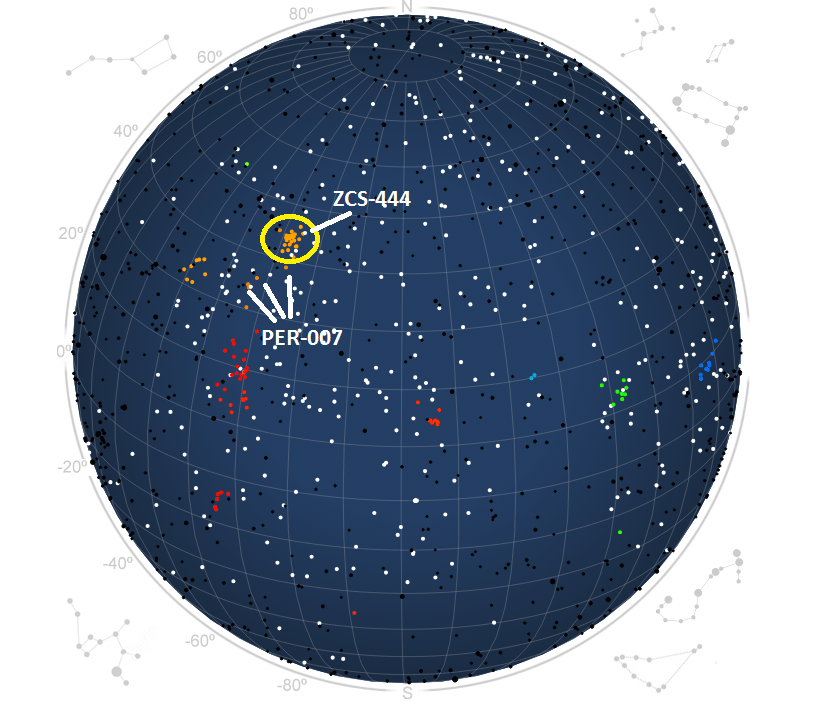
Figure 1 – Screenshot of the CAMS radiant plot for the night of 2018 July 15 with the Zeta Cassiopeiids (ZCS-444) as well as a few ‘real’ early Perseid radiants.
2 ZCS (444) history
This shower was discovered in 2012 by the Croatian Meteor Network from a radiant analysis on the 853 orbits collected in 2007 which failed association with any known meteor stream (Šegon et al., 2012). The discovery followed a detailed analysis of the 2007 CMN orbit data and CMN data of the following years as well as on the available SonotaCo orbit data. As many as 55 orbits fulfilled the Southworth and Hawkins discrimination criteria DSH < 0.15 and allowed the computation of an accurate reference orbit, radiant drift as well as other shower characteristics.
At about the same time when the CMN-team revealed the presence of the ζ-Cassiopeiids from its orbit catalogue, the Polish Comets and Meteors Workshop published a paper with their data on this new shower (Żołądek and Wiśniewski, 2012). On July 14–15, 2005 Polish visual observers had noticed a large number of bight meteors radiating from a position slightly west of the expected early Perseid radiant, close to the star ζ-Cassiopeiae. A remarkably high number of meteors were captured on the Polish video cameras, including a spectacular fireball, with about half of all these meteors coming from a common radiant. 20 members of a potential new shower were found in the records of three PFN stations. Almost all meteors were captured after 23h UT, some of them in the morning twilight. The Polish observers concluded in 2005 they observed an outburst of this new unknown radiant. Unfortunately, due to unfavorable geometrics no accurate orbit could be derived for the new shower.
The ZCS#444 shower was also confirmed by the shower search on the CAMS orbits obtained in 2011 and 2012 (Jenniskens et al., 2016). Strange enough, it is still waiting to be recognized as an established meteor shower despite the weight of evidence for the existence of this shower.
The photographic meteor orbit catalogue with 4873 accurate photographic orbits obtained between 1936 and 2008 resulted in only eight possible ζ-Cassiopeiids orbits, in 1953, 1956, two in 1958, 1959, 1965, 1969 and 1979. Four of these orbits match the ζ-Cassiopeiids parent orbit within a high threshold D-Criterion. The Harvard radar orbit catalogues 1961–1965 and 1968–1969 (Hawkins, 1963) contain only one orbit with a high threshold of DD < 0.04. The rather small number of ζ-Cassiopeiid orbits collected before the large-scale video meteor observing networks got started explains why this shower wasn’t noticed earlier.
3 The available orbit data
We have the following data, status as until July 2018, available for our search:
- EDMOND EU+world with 317830 orbits (until 2016). EDMOND collects data from different European networks which altogether operate 311 cameras (Kornos et al., 2014).
- SonotaCo with 257010 orbits (2007–2017). SonotaCo is an amateur video network with over 100 cameras in Japan (SonotaCo, 2009).
- CAMS with 111233 orbits (October 2010 – March 2013), (Jenniskens et al., 2011). For clarity, the CAMS BeNeLux orbits April 2013 – July 2018 are not included in this dataset because this data is still under embargo.
Altogether we can search among 686073 video meteor orbits. The methodology has been explained in a previous series of shower analyses (Roggemans and Johannink, 2018; Roggemans, 2018; Roggemans and Campbell-Burns, 2018a, 2018b, 2018c, 2018d).
4 Orbit selection
In a first approach the entire dataset was searched for orbits similar to the ZCS reference orbit from literature in order to determine the minimum and maximum values for a selection on [λʘ, αg, δg, vg]. This resulted in a selection of orbits within the following intervals:
- Time interval: 97° < λʘ < 125°;
- Radiant area: 350° < αg < 22° & +41° < δg < +60°;
- Velocity: 51 km/s < vg < 62 km/s.
In total 3149 orbits were selected. The median values of this first selection were used as parent orbit to calculate the discrimination criteria for all individual orbits. We apply three discrimination criteria to evaluate the similarity between the individual orbits and the parent orbit. The D-criteria used are these of Southworth and Hawkins (1963), Drummond (1981) and Jopek (1993). We consider four different threshold levels of similarity:
- Low: DSH < 0.25 & DD < 0.105 & DH < 0.25;
- Medium low: DSH < 0.2 & DD < 0.08 & DH < 0.2;
- Medium high: DSH < 0.15 & DD < 0.06 & DH < 0.15;
- High: DSH < 0.1 & DD < 0.04 & DH < 0.1.
The median values of the orbits with DD < 0.04 were taken as new parent orbit to recalculate the D-criteria and this procedure was repeated a second time to have a best reference orbit. The final resulting median values for the low threshold criteria is presented in Table 1 for each sub-dataset, CAMS, EDMOND and SonotaCo and the median values for each threshold level are listed in Table 2.
Although all 3149 selected orbits produced meteors that would appear to be a perfect match as ζ-Cassiopeiid, with the right speed and direction for a single station observer anywhere, a remarkably high proportion of these look-a-likes fail to fulfill even the weakest D-criteria. The nearby early Perseid radiant may explain to some extent the important sporadic or rather other shower contamination of the selection. This explains why this shower remained ‘invisible’ for visual observers until the small outburst in 2005 caught the attention of the Polish team. It is a pity that no performant camera networks were active at the time of the reported outburst (2005).
Table 1 – The median values for each sub-set of orbits that fulfill DD<0.105, CAMS, SonotaCo and EDMOND, all combined orbits and the final parent orbit derived for DD < 0.04.
| CAMS | SonotaCo | Edmond | All | Final parent |
|
| λʘ | 114.1° | 114.6° | 114.6° | 114.6° | 113.7° |
| αg | 8.2° | 9.1° | 9.5° | 9.1° | 7.7° |
| δg | +51.2° | +51.3° | +51.4° | +51.3° | +51.1° |
| vg | 57.2 | 57.4 | 56.9 | 57.1 | 56.9 |
| a | 13.7 | 12.6 | 9.4 | 10.6 | 13.0 |
| q | 0.992 | 0.992 | 0.991 | 0.992 | 0.995 |
| e | 0.943 | 0.953 | 0.906 | 0.923 | 0.923 |
| ω | 162.0° | 161.8° | 161.5° | 161.7° | 163.1° |
| Ω | 114.0° | 114.6° | 114.6° | 114.6° | 113.7° |
| i | 107.5° | 107.9° | 107.6° | 107.6° | 107.3° |
| N | 213 | 357 | 798 | 1368 | 264 |
Table 2 – The median values for the final selection of orbits with four different threshold levels on the D-criteria, compared to the reference orbit from literature (Jenniskens et al., 2018).
| Low | Medium low | Medium high | High | Reference (2018) | |
| λʘ | 114.6° | 114.1° | 113.7° | 113.7° | 111.5° |
| αg | 9.1° | 8.5° | 7.8° | 7.7° | 5.1° |
| δg | +51.3° | +51.2° | +51.0° | +51.1° | +50.2° |
| vg | 57.1 | 57.1 | 57.1 | 56.9 | 57.1 |
| a | 10.6 | 11.8 | 12.6 | 13.0 | 12.8 |
| q | 0.992 | 0.994 | 0.995 | 0.995 | 0.996 |
| e | 0.923 | 0.925 | 0.926 | 0.923 | 0.946 |
| ω | 161.7° | 162.4° | 163.1° | 163.1° | 164.0° |
| Ω | 114.6° | 114.1° | 113.7° | 113.7° | 111.5° |
| i | 107.6° | 107.6° | 107.5° | 107.3° | 107.1° |
| N | 1368 | 884 | 541 | 264 | 445 |
| S | 57% | 72% | 83% | 92% |
With a rich sporadic background activity mixed with widely scattered early Perseids in the suspected region of the sky, the question arises if there is really another shower present, or whether this is a spurious combination of look-alike orbits? When we plot the inclination i against the length of perihelion Π for all our 3149-selected candidate ζ-Cassiopeiids orbits, we see a distinct and compact concentration (Figure 2), which indicates the presence of a real concentrations of similar orbits at this position.
Could these ζ-Cassiopeiids be somehow related to the Perseids which have their maximum activity about 4 weeks later? Applying our D-criteria with the Perseid reference orbit as parent orbit for the 3149-selected candidate ζ-Cassiopeiids orbits did not have any single orbit that fulfilled the D-criteria. The Perseids have an inclination about 6° higher than the ζ-Cassiopeiids, but the main difference is in the length of perihelion П with 277° for ζ-Cassiopeiids against 289° for Perseids, with a difference in the argument of perihelion of about 14° less and 26° more in the ascending node for the Perseid orbit. The separation in time is too large between both meteor streams to find any association based on D-criteria.
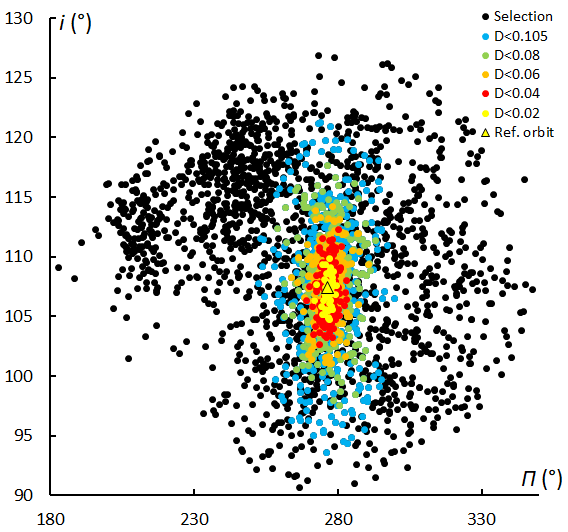
Figure 2 – The plot of inclination i (°) against the length of perihelion П (°) for the 3149 selected possible ZCS-orbits. The colors mark the different threshold levels of the D-criteria relative to the final parent orbit listed in Table 1.
5 Case study ZCS-444: results
The 1368 probable ZCS-orbits that fulfill the minimal threshold represent only 43% of the 3149 selected orbits. In other words, less than one in two meteors that look like a ζ-Cassiopeiid for an observer has an orbit that is like the ζ-Cassiopeiid orbit while the other is a sporadic lookalike. With the early Perseid radiant nearby it is obvious why these meteors cannot be properly identified from single station observations. This implies that past single station radiant determinations for early Perseids will be strongly contaminated by these ζ-Cassiopeiids.
With the current availability of a statistical significant number of orbits the shower characteristics of the ζ-Cassiopeiids can be determined.
Activity period and maximum
The first possible ζ-Cassiopeiid orbit has been detected at λʘ = 101°, the last one at λʘ = 125° with the main activity detected between λʘ = 110° and λʘ = 118°, about July 12 and July 21. Maximum occurred at ~ λʘ = 112.75° or July 15–16. The CAMS BeNeLux network had clear nights around this time and could collect plenty of ζ-Cassiopeiid orbits. In this case study we do not use any 2018 data, but the long-term orbital data obtained from 2006 until 2017 by camera networks across the globe.
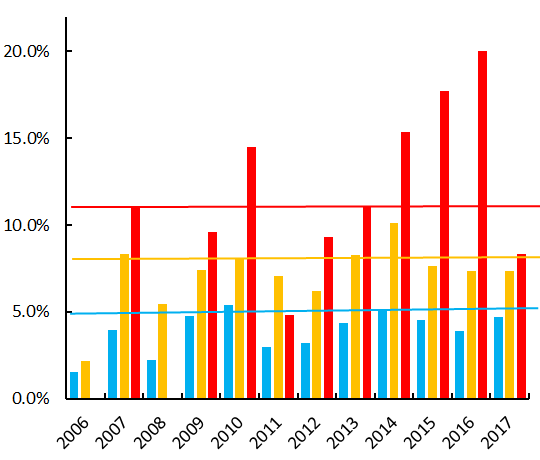
Figure 3 – The percentage of ZCS orbits relative to the total number of orbits obtained per year for different intervals of its activity period: Total activity period (DD < 0.105, blue), the main activity period (110° < λʘ < 118°, orange) and the maximum at λʘ = 112.75°± 0.25° (red).
When the ζ-Cassiopeiids were noticed the very first time by dedicated visual observers in Poland in 2005 the activity level was described as an outburst. The Polish team checked its visual records 1996–2000 and did not find any activity above the level corresponding to a Zenithal Hourly Rate of 2. If the ζ-Cassiopeiids produced a real outburst in 2005 this might be an indication for some periodicity. It makes no sense to calculate ZHR values for minor showers. Counting the number of orbits identified as ζ-Cassiopeiids for each year of our dataset already confirms the annual activity. The absolute numbers are affected by variable weather circumstances and different observing capacities from year to year. To eliminate these factors, we use the total number of orbits registered per time interval to calculate the relative strength of the ζ-Cassiopeiids as a percentage of the total number of orbits registered in each period of time.
The relative activity for each year is presented in Figure 3. For the complete activity period 100° < λʘ < 125°, with dispersed shower orbits, 3.9% of all orbits fulfill the low threshold D-criteria for the shower. For the main activity period 110° < λʘ < 118°, as many as 7.5% of all orbits match with the ZCS parent orbit. Considering a period of ±6 hours around the time of maximum activity at
λʘ = 112.75° the percentage reached 20% in 2016 while in 2011 the relative activity level was only 4.8% of all orbits with a statistical relevant number of orbits collected that year. Such strong variation from one year to another may indicate some periodic variation in strength, however the available data does not yet allow further details to be determined. With 11.5% of all orbits during the ζ-Cassiopeiids maximum belonging to this shower the activity should easily catch the attention of any experienced meteor observer.
The number of orbits per degree of solar longitude collected by all networks worldwide over a period of 12 years offers a way to reconstruct the activity profile. In Figure 2 we see the dispersion on the orbits in inclination against length of perihelion. The further away from the center of the stream (parent orbit), the weaker the D criteria. In Figure 4 we display the number of orbits per degree of solar longitude for each threshold level of D-criteria. These absolute numbers based on a large mixture of data collected over a long period of time (12 years) may have smoothed out influences such as zenith distance of the radiant, different observing circumstances, etc. To eliminate the effect of observing circumstances we use the total number of orbits collected in the considered time lapse to consider the relative activity as a percentage of the total number of orbits collected. In Figure 5 we reproduce the result for the four threshold levels. The shape of the profile is about the same as in Figure 4 with the absolute numbers.
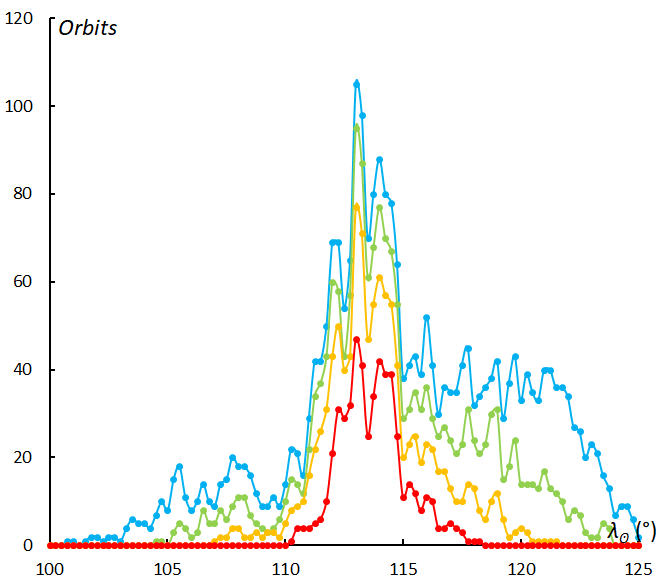
Figure 4 – The number of ζ-Cassiopeiids orbits collected per degree of solar longitude λʘ during the period 2007–2017 with blue for DD < 0.105, green for DD < 0.08, orange for DD < 0.06 and red for DD < 0.04.
The profile starts with low activity with low threshold orbits with a distinct main activity from λʘ = 110° until λʘ = 118°. Peak activity is reached at λʘ = 112.75° followed by a dip and a secondary maximum at λʘ = 114.5°. The ‘shoulder’ of the activity profile after the maximum may be contaminated by early Perseids that fulfil the low and medium low threshold D-criteria for the ZCS parent orbit. In Figure 6 we display the average value for the geocentric velocity vg and the inclination i for each degree of solar longitude. The orbits in the right wing of the profile of Figures 4 and 5 include more particles with a higher geocentric velocity and higher inclination. These faster particles with higher inclination are likely early Perseids that fulfill the low and medium low threshold for the ZCS parent orbit. Żołądek and Wiśniewski (2012) made a similar graphic but comparing the ZCS average geocentric velocities with those of real early Perseids. The ζ-Cassiopeiids fade away when the early Perseids move on the foreground.
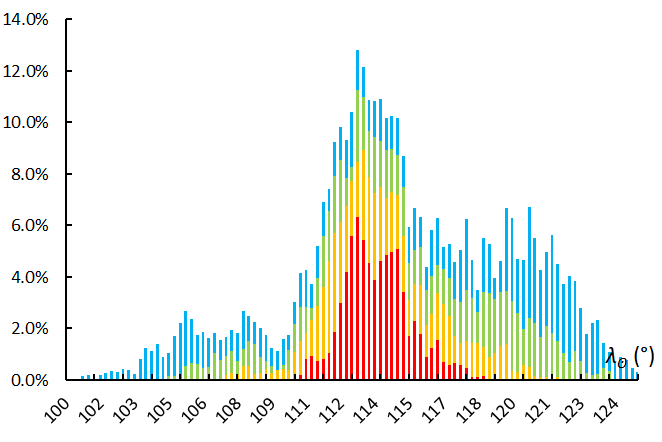
Figure 5 – The relative number of ζ-Cassiopeiids orbits collected per degree of solar longitude λʘ during the period 2007–2017, with blue for DD < 0.105, green for DD < 0.08, orange for DD < 0.06 and red for DD < 0.04, as percentage of the total number of orbits collected in the same time span.
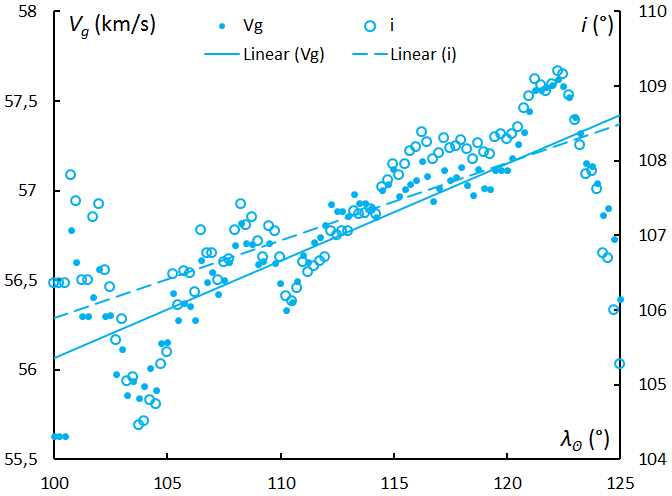
Figure 6 – The average values for the geocentric velocity vg and the inclination i per degree of solar longitude. The increase of both values indicates contamination of the post maximum activity with early Perseids that fit low threshold D-criteria with the ZCS parent orbit.
Radiant position, size and drift
The radiant drift has been calculated for the 4 different threshold levels, the results are listed in Table 3, including the standard deviation. The low threshold orbits (blue) appear mainly dispersed ahead over a long period of time while the high threshold orbits are concentrated in the main activity period of the shower. The very high threshold orbits (DD < 0.02) are marked in yellow (Figures 7 and 8).
Table 3 – Radiant drift with ± σ for the ζ-Cassiopeiids obtained from the orbits for each threshold level of the D-criteria.
|
Threshold level |
ZCS – 444 | |
| Δα / λʘ | Δδ / λʘ | |
| Low | 1.27 ± 0.02 | +0.36 ± 0.01 |
| Medium low | 1.32 ± 0.02 | +0.36 ± 0.02 |
| Medium high | 1.40 ± 0.03 | +0.30 ± 0.02 |
| High | 1.43 ± 0.05 | +0.28 ± 0.05 |
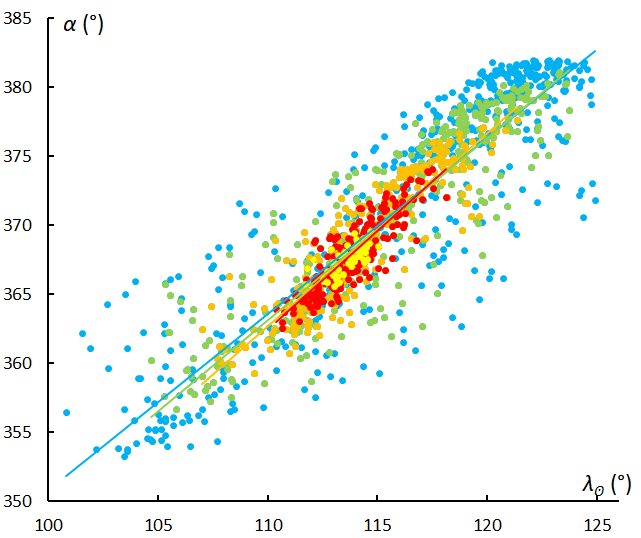
Figure 7 – Radiant drift in Right Ascension α against solar longitude λʘ. The different colors represent the 5 different levels of similarity, blue for DD < 0.105, green for DD < 0.08, orange for DD < 0.06, red for DD < 0.04 and yellow for DD < 0.02.
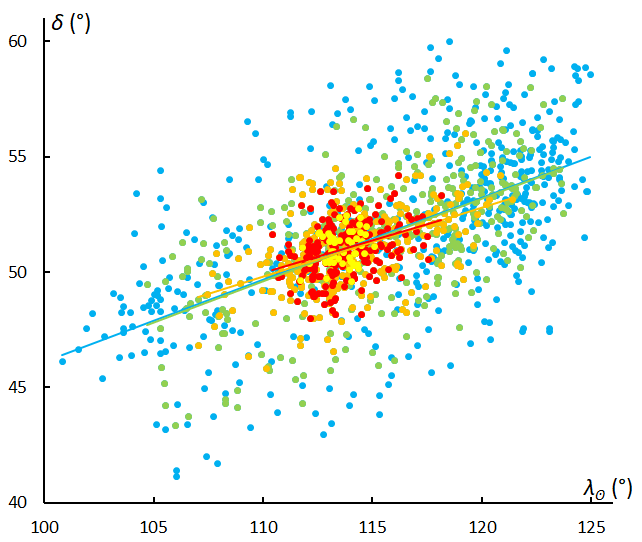
Figure 8 – Radiant drift in declination δ against solar longitude λʘ. The different colors represent the 5 different levels of similarity, blue for DD < 0.105, green for DD < 0.08, orange for DD < 0.06, red for DD < 0.04 and yellow for DD < 0.02.
The values for radiant drift are in very good agreement with previous studies. Żołądek and Wiśniewski (2012) found Δα / λʘ = 1.9 and Δδ / λʘ = +0.4. Šegon et al. (2012) found Δα / λʘ = 1.4 and Δδ / λʘ = +0.5. Jenniskens et al. (2016) published Δα / λʘ = 0.95 and Δδ / λʘ = +0.4. These results show a radiant which moves fast north east and this is confirmed by our results in Table 3.
The radiant drift is effectively valid for most ZCS orbits. When we compare the scattered positions of the 3149 uncorrected radiant positions in Figure 9 with the radiant drift corrected positions in Figure 10, the sporadic radiants (black) gets even more dispersed while the ζ-Cassiopeiids contract into a rather compact radiant. The same picture emerges from the plot of the ecliptic latitude β against the Sun centered longitude λ – λʘ (Figure 11).
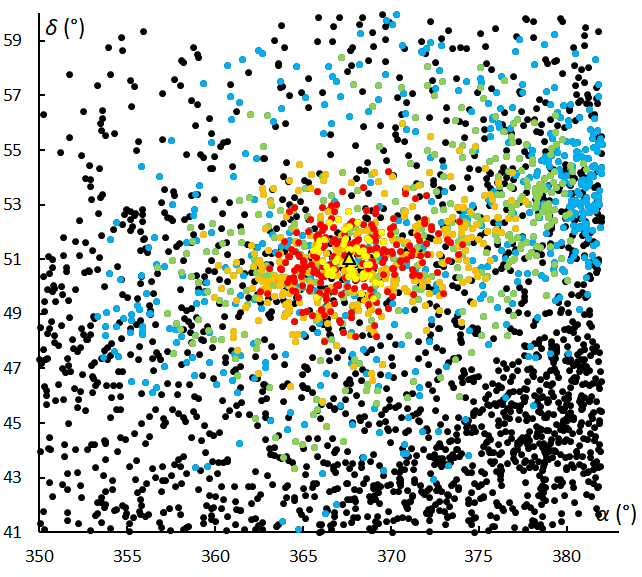
Figure 9 – Plot of the 3149 uncorrected radiant positions as selected. The different colors represent the 5 different levels of similarity according to different threshold levels in the D-criteria.
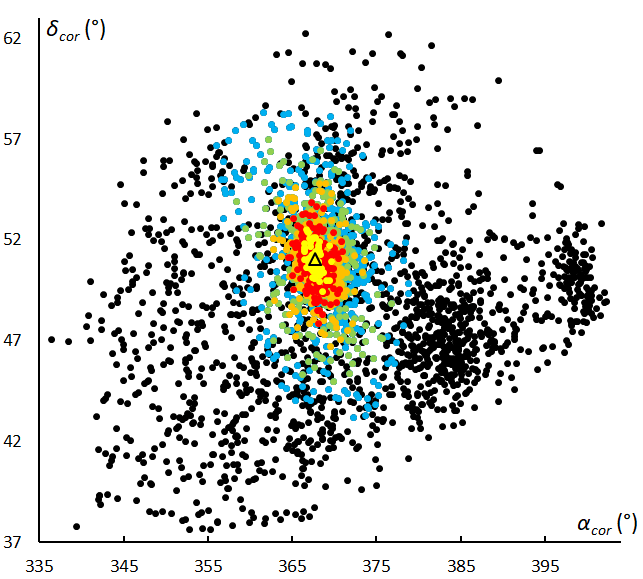
Figure 10 – Plot of the radiant drift corrected radiant positions. The different colors represent the 5 different levels of similarity.
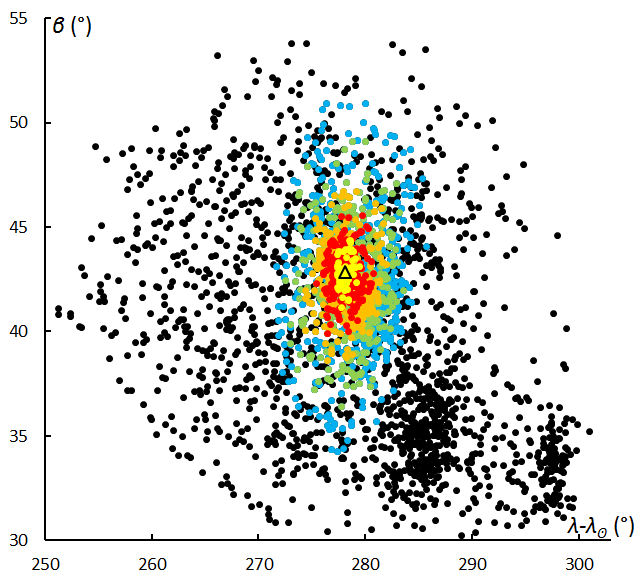
Figure 11 – Plot of the ecliptic latitude β against the Sun centered longitude λ – λʘ. The different colors represent the 5 different levels of similarity.
Other shower characteristics
The elevation of the ablation of meteors depends mainly on two factors; the entry velocity and the structure and composition of the meteoroid particle. ZCS meteors being rather fast meteors with ~57 km/s have their ablation process starting and ending well above the average meteor elevations in the atmosphere. The results are shown in Table 4 for different threshold levels of the D-criteria.
Table 4 – Beginning and ending heights with ± σ for the ζ-Cassiopeiids obtained from the orbits for each threshold level of the D-criteria.
|
Threshold level |
ZCS – 444 | |
| Hbeg | Hend | |
| Low | 107.9 ± 4.3 km | 94.7 ± 5.8 km |
| Medium low | 108.0 ± 4.2 km | 94.7 ± 5.8 km |
| Medium high | 108.3 ± 4.1 km | 94.8 ± 5.8 km |
| High | 108.3 ± 4.1 km |
94.4 ± 5.8 km |
The closest matching major shower with similar values are the Perseids (PER#007) with a geocentric velocity of
59.1 km/s and Hbeg = 110.9 ± 4.0 and Hend = 98.0 ± 4.8 km (Roggemans, 2017). Although the ζ-Cassiopeiids are only slightly slower than Perseids, their ablation seems to happen slightly deeper in the atmosphere than what one may expect.
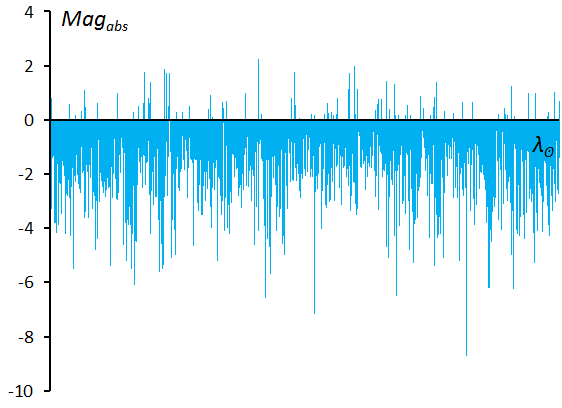
Figure 12 – The absolute magnitude of all 1368 low threshold ζ-Cassiopeiids from λʘ 100° to 125°.
One explanation could be that the ζ-Cassiopeiids consist of slightly older less fragile cometary particles that manage to get a bit deeper into the atmosphere before being completely disintegrated. Another indication that the shower is rather old is the remarkable dominance of bright meteors and absence of faint meteors with mabs = –1.3 [–8.7 to +2.2]. The dominance of bright meteors in the registered ζ-Cassiopeiids activity becomes very clear when we plot the magnitudes for all events collected between λʘ = 100° and λʘ = 125° (Figure 12). ZSC meteors fainter than magnitude 0 are a small minority. The strong presence of bright meteors among ζ-Cassiopeiids was already mentioned in the analysis by Šegon et al. (2012), but then a possible explanation could be that the camera networks captured mainly bright meteors and nothing much fainter than +2. Including CAMS which captures meteors of +4, the absence of faint meteors in this shower remains obvious.
Dr. Peter Jenniskens classifies the ζ-Cassiopeiids with retrograde showers of Halley type comets and suggests that the ζ-Cassiopeiids may be a component which also originates from 109P/Swift–Tuttle although the difference in inclination and difference in length of perihelion is significant (Π = 278° versus 292° according to Jenniskens et al., 2016). Peter Jenniskens also says that this fits a trend of changing Π versus λʘ.
Making a plot of length of perihelion Π against λʘ (see Figure 13), displays such trend for which we find:
ΔΠ / λʘ = 0.62 ± 0.03°
If we extrapolate this beyond the observed activity period of the ζ-Cassiopeiids we get at Π = 291.8° for λʘ = 140° which is very close to the value of the Perseids at that time.
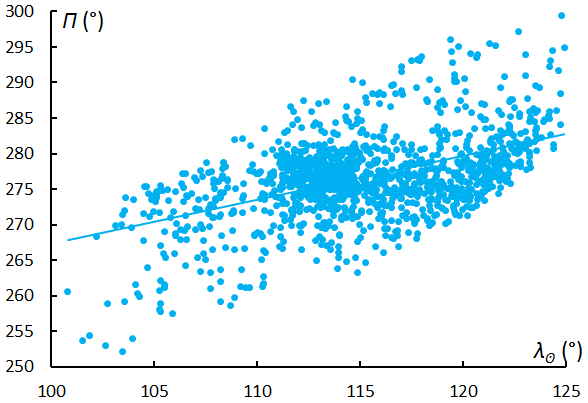
Figure 13 – The length of perihelion Π against solar longitude λʘ for the 1368 low threshold orbits.
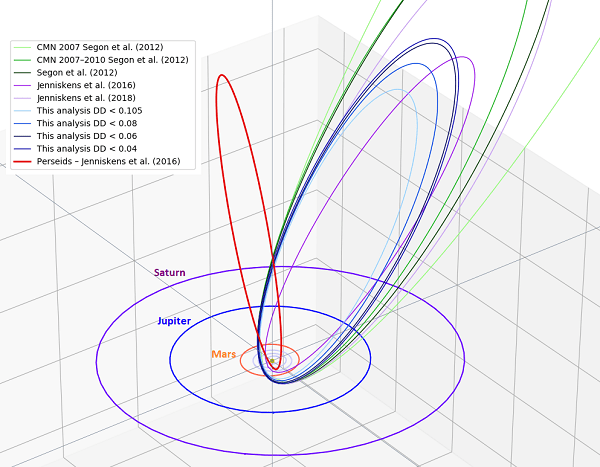
Figure 14 – The different ζ-Cassiopeiid reference orbits from Table 5 compared to the reference orbit of the Perseids. (Author Peter Cambell-Burns).
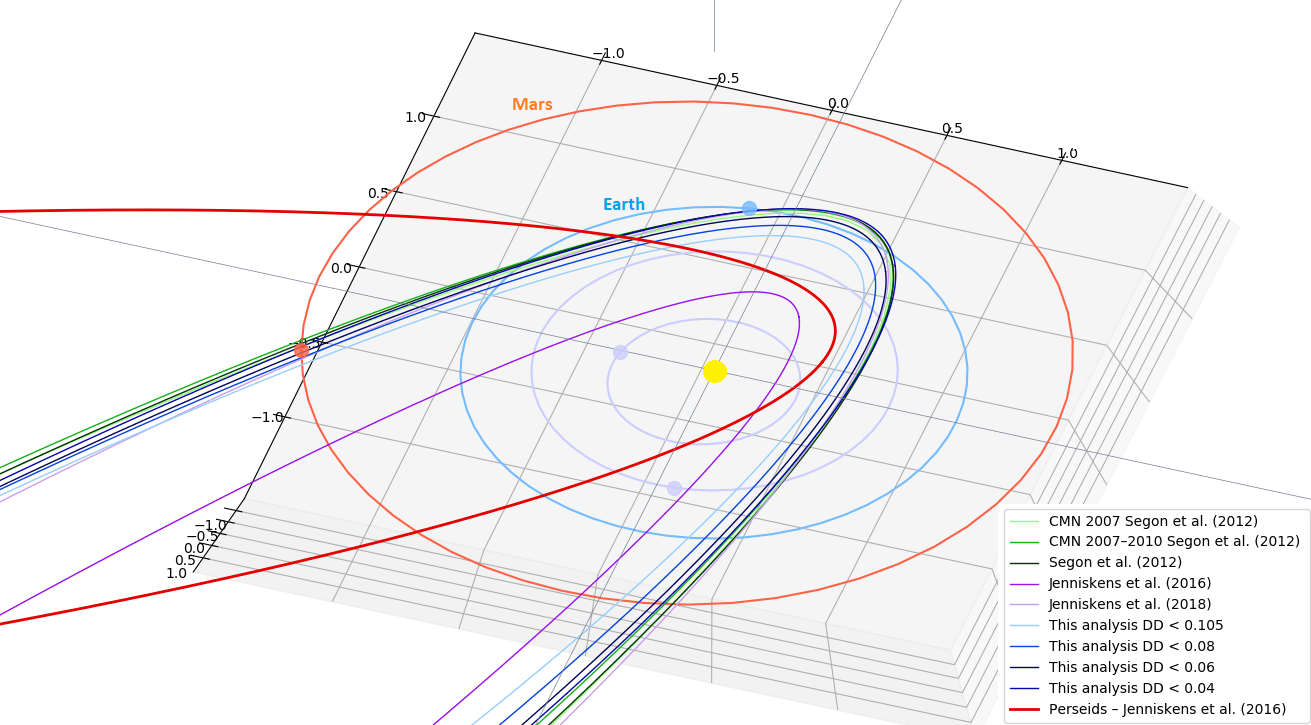
Figure 15 – The different ζ-Cassiopeiids reference orbits from Table 5, close-up near the node and perihelion, compared to the reference orbit of the Perseids (Author Peter Cambell-Burns).
Table – 5 The orbital data for the ζ-Cassiopeiids (ZCS-444) all J2000, the standard deviation σ is listed as ± where available. The orbit of the Perseids is also given.
| λʘ(°) | αg(°) | δg(°) | Δα(°) | Δδ(°) | vgkm/s | aAU | qAU | e | ω(°) | Ω(°) | i(°) | N | Source |
| – | – | – | – | – | – | 46.7 | 0.996±0.002 | 0.979±0.044 | 164.9±1.0 | 113.3±0.3 | 107.1±0.5 | 13 | CMN 2007Šegon et al. (2012) |
| – | – | – | – | – | – | 18.6 | 0.995±0.001 | 0.947±0.012 | 163.2±0.5 | 113.7±0.4 | 107.5±0.5 | 25 | CMN 2007–2010 Šegon et al. (2012) |
| 113.2 | 6.9 | 50.7 | +1.4 | +0.5 | 57.3±1.0 | 20.3 | 0.997±0.001 | 0.951±0.008 | 163.9±0.3 | 113.2±0.2 | 107.5±0.3 | 55 | Šegon et al. (2012) |
| 109.0 | 3.1 | 49.5 | +1.0 | +0.4 | 57.1 | 12.8 | 1.000 | 0.962 | 165.4 | 112.1 | 106.6 | 118 | Jenniskens et al. (2016) |
| 111.5 | 5.1 | 50.2 | – | – | 57.1 | 18.4 | 0.996 | 0.946 | 164.0 | 111.5 | 107.1 | 445 | Jenniskens et al. (2018) |
| 114.6 | 9.1 | 51.3 | +1.3 | +0.4 | 57.1 | 10.6 | 0.992±0.014 | 0.923±0.077 | 161.7±5.3 | 114.6±4.6 | 107.6±4.0 | 1368 | This analysis DD < 0.105 |
| 114.1 | 8.5±5.1 | 51.2±2.1 | +1.3 | +0.4 | 57.1±1.2 | 11.8 | 0.994±0.011 | 0.925±0.064 | 162.4±4.1 | 114.1±3.4 | 107.6±3.0 | 884 | This analysis DD < 0.08 |
| 113.7 | 7.8±3.6 | 51.0±1.4 | +1.4 | +0.3 | 57.1±1.0 | 12.8 | 0.995±0.008 | 0.926±0.052 | 163.1±3.2 | 113.7±2.3 | 107.5±2.2 | 541 | This analysis DD < 0.06 |
| 113.7 | 7.7±2.3 | 51.1±1.1 | +1.4 | +0.3 | 56.9±0.7 | 13.0 | 0.995±0.006 | 0.923±0.036 | 163.1±2.2 | 113.7±1.4 | 107.3±1.8 | 264 | This analysis DD < 0.04 |
| 140 | 48.2 | 58.1 | 59.1 | 9.6 | 0.949 | 0.950 | 150.4 | 139.3 | 113.1 | 4367 | Perseids – Jenniskens et al. (2016) |
Figures 14 and 15 show the significant ‘gap’ between the ζ-Cassiopeiids orbit and the Perseids orbit. If and how the parent body of the ζ-Cassiopeiids is related to 109P/Swift–Tuttle remains a challenge for stream modelers to reconstruct the possible history of a common parent body. In such case it might be necessary to reconsider the ancient records of the Perseids if these were really Perseids or rather ζ-Cassiopeiids.
6 Conclusion
A significant number of ζ-Cassiopeiids have been identified which allowed a detailed case study on this shower. Yearly activity has been detected with a rather large variation from year to year that may indicate some periodicity, like suggested by the outburst observed in 2005, before systematic video camera networks were operational. The time of maximum activity could be established at λʘ = 112.75° with a secondary maximum at λʘ = 114.5°. The post maximum wing of the activity profile includes early Perseid orbits that qualify for the ζ-Cassiopeiid parent orbit. All shower characteristics are identical to the nearby Perseid shower although ζ-Cassiopeiids are likely older. Both showers may be related to a common origin.
This shower qualifies to get listed as an established meteor shower in the IAU working list of meteor showers.
Acknowledgment
The authors are very grateful to Jakub Koukal for updating the dataset of EDMOND with the most recent data, to SonotaCo Network (Simultaneously Observed Meteor Data Sets SNM2007–SNM2017), to CAMS (2010–2013) and to all camera operators involved in these camera networks.
References
Drummond J. D. (1981). “A test of comet and meteor shower associations”. Icarus, 45, 545–553.
Hawkins G. S. (1963). “The Harvard radio meteor project”. Smithsonian Contributions to Astrophysics, 7, 53–62.
Jenniskens P., Gural P. S., Grigsby B., Dynneson L., Koop M. and Holman D. (2011). “CAMS: Cameras for Allsky Meteor Surveillance to validate minor meteor showers”. Icarus, 216, 40–61.
Jenniskens P., Nénon Q., Albers J., Gural P. S., Haberman B., Holman D., Morales R., Grigsby B. J., Samuels D. and Johannink C. (2016). “The established meteor showers as observed by CAMS”. Icarus, 266, 331–354.
Jenniskens P., Baggaley J., Crumpton I., Aldous P., Pokorny P., Janches D., Gural P. S., Samuels D., Albers J., Howell A., Johannink C., Breukers M., Odeh M., Moskovitz N., Collison J. and Ganjuag S. (2018). “A survey of southern hemisphere meteor showers”. Planetary Space Science, 154, 21–29.
Jopek T. J. (1993). “Remarks on the meteor orbital similarity D-criterion”. Icarus, 106, 603–607.
Kornoš L., Matlovič P., Rudawska R., Tóth J., Hajduková M. Jr., Koukal J. and Piffl R. (2014). “Confirmation and characterization of IAU temporary meteor showers in EDMOND database”. In Jopek T. J., Rietmeijer F. J. M., Watanabe J., Williams I. P., editors, Proceedings of the Meteoroids 2013 Conference, Poznań, Poland, Aug. 26-30, 2013. A.M. University, pages 225–233.
Roggemans P. (2017). “Variation in heights of CAMS meteor trajectories”. eMetN, 2, 80–86.
Roggemans P. (2018). “August gamma Cepheids (523-AGC)”. eMetN, 3, 73–78.
Roggemans P. and Cambell-Burns P. (2018a). “x Herculids (XHE-346)”. eMetN, 3, 120–127.
Roggemans P. and Cambell-Burns P. (2018b). “February Hydrids (FHY-1032)”. eMetN, 3, 128–133.
Roggemans P. and Cambell-Burns P. (2018c). “Alpha Aquariids (AAQ-927)”. eMetN, 3, 134–141.
Roggemans P. and Cambell-Burns P. (2018d). “Eta Lyrids (ELY-145)”. eMetN, 3, 142–147.
Roggemans P. and Johannink C. (2018). “A search for December alpha Bootids (497)”. eMetN, 3, 64–72.
Šegon D., Andreić Ž., Korlević K., Gural P., Novoselnik F., Vida D. and Skolić I. (2012). “New shower in Cassiopeia”. WGN, Journal of the International Meteor Organization, 40, 195–200.
SonotaCo (2009). “A meteor shower catalog based on video observations in 2007-2008”. WGN, Journal of the International Meteor Organization, 37, 55–62.
Southworth R. R. and Hawkins G. S. (1963). “Statistics of meteor streams”. Smithson. Contrib. Astrophys., 7, 261–286.
Żołądek P.and Wiśniewski M. (2012). “The new July meteor shower”. WGN, Journal of the International Meteor Organization, 40, 189–194.




